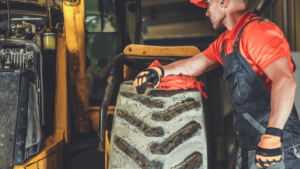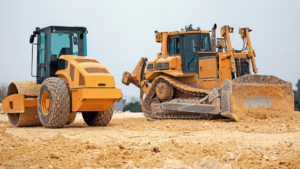Being a construction worker means you get to be physically active and spend a lot of time outdoors.
On top of that, your job brings something new every day, and you get to see the immediate results of your work.
However, according to statistics, it also means you’re working in one of the most dangerous sectors in both the United States and the world.
In fact, the U.S. Bureau of Labor Statistics reported over 1,000 fatal work injuries in the construction sector in 2020. This means that one in five worker deaths in the U.S. occurred in construction.
As for the world, the International Labor Organization (ILO) estimated that the construction sector accounts for one in every six fatal work injuries.
This article explores the common safety mistakes that occur at construction sites, so keep reading to find out what they are and how you can avoid them to keep your workers safe.
In this article...
Not Keeping the Site Clean
Keeping a clean site can eliminate a multitude of workplace hazards and prevent many fatal and non-fatal injuries.
The good news is that, compared to 2019, the overall number of fatal work injuries in the U.S. went down by 10.7% in 2020, according to a study conducted by the U.S. Bureau of Labor Statistics.
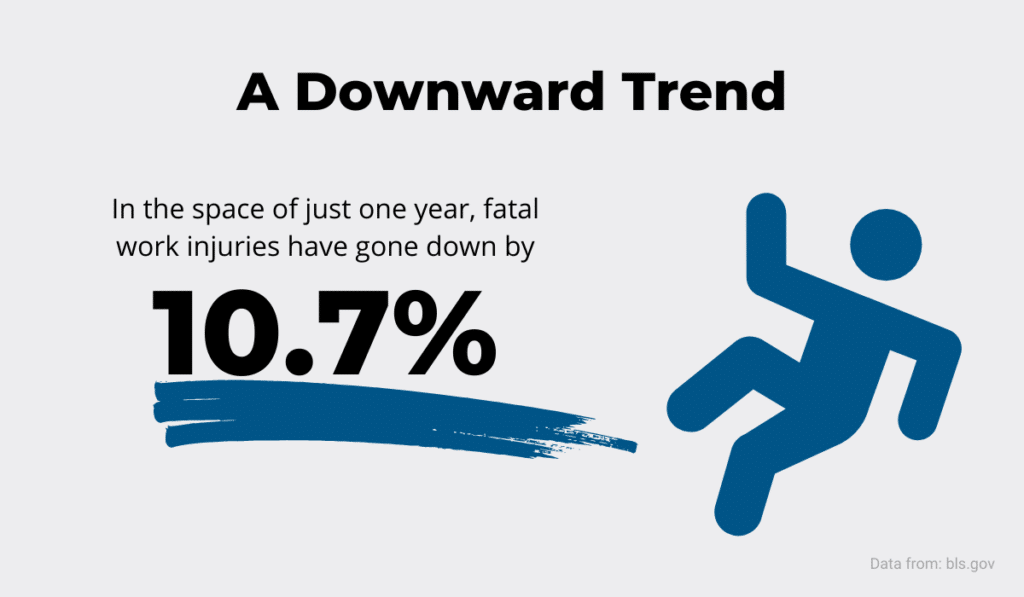
The bad news is that, in addition to having the highest number of fatal injuries, the construction sector also leads the way in fatal falls.
One in three fatalities in 2020 resulted from slips, trips and falls, according to the previously cited study by the U.S. Bureau of Labor Statistics.
How many of them were caused by debris, tools or cables left lying around on a construction site?
More than you’d think. In fact, the Occupational Safety and Health Administration (OSHA) recognizes how dangerous a messy construction site can be and goes into detail to describe the perils of “poor housekeeping.”
Basically, this includes:
- Tripping and falling hazards
- Slipping hazards
- Cutting and puncturing hazards
One of the three things OSHA inspectors are especially keen on is a clean and orderly site.
In fact, that’s usually the third item on their inspection checklist (more on the first two later).
For now, keep in mind that construction sites contain a plethora of accident hazards even when they’re pristine.
Therefore, if you fail to introduce a safety-first culture or insist on a clean site, those hazards only multiply.
And, unlike many of the other items in this article, keeping a site clean doesn’t require that much effort or resources, and it should be a shared responsibility of the entire construction team.
To sum up, worksite cleanliness is one of the easiest things you can do to increase worker safety and prevent injuries that can occur because of workers slipping or tripping at work.
Not Following the LOTO Standard
Not removing faulty equipment can mean anything from leaving a worn-out saw on site for somebody to get cut on, potentially causing a minor injury, to not following the lockout/tagout (LOTO) standard, and possibly causing a fatal one.
In 2020, most fatal work accidents occurred because of falls and contact with equipment.
If you’re interested in falls, they’re covered under “Neglecting Proper PPE”.
As for contact with equipment, it makes sense to take a deeper look.
According to OSHA, compliance with LOTO procedures could save a lot of lives, and prevent a staggering amount of non-fatal injuries.
For those who don’t know, the LOTO standard refers to a set of lockout/tagout procedures necessary to ensure that, before and during its maintenance and repair, dangerous equipment or machinery is:
- Properly shut down
- De-energized (when required)
- The power supply is shut off
In other words, a lockout device (e.g., hasps and padlocks) is used to ensure that the machine’s power source stays shut off.
This is followed by placing a tagout device on an energy isolating device (i.e., power supply switch), indicating that the machine may not be operated until the tagout device is removed.
It’s a simple enough procedure to follow and it can prevent a staggering number of injuries and deaths.
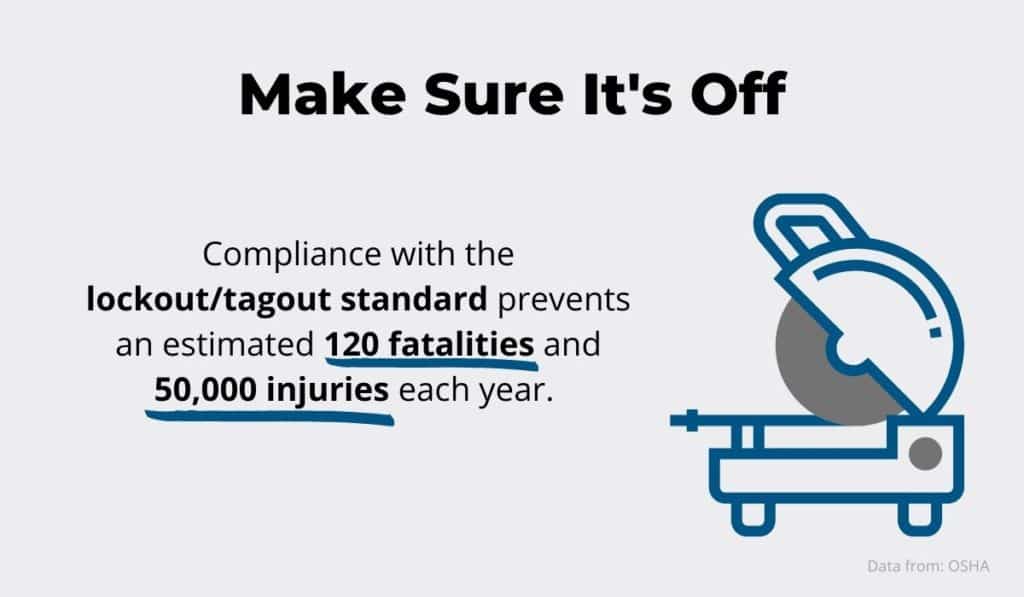
Here is an example of a fatal LOTO mistake.
If you’ve watched it, you probably see why most LOTO accidents happen when workers are close to the moving parts of machinery.
In fact, this video shows two errors with fatal consequences:
Firstly, the machine was neither locked out nor tagged out. This enabled the operator to start it—this is a violation of LOTO regulations.
Secondly, the operator decided to turn the machine on without asking himself why it was off in the first place—this is a human error.
It’s human to err, and the causes can be quite varied, from human nature, to a force of habit or a moment of distraction.
However, in the example above, the cause was something much less difficult to deduce. The mistake was the result of a failure to comply with the prescribed safety procedures.
If the operator had simply followed the proper procedure, the accident could have been avoided.
In short, keep in mind that following the right steps and using the appropriate LOTO devices (security locks, locks, and safety tags) is essential for a safe working environment.
Neglecting Proper PPE
In any industry that involves manual labor, using personal protective equipment (PPE) is a lifesaver. Literally.
The same goes for construction.
Construction companies and sites will usually adhere to their own specific PPE standards, but a lot of these practices are universal.
For example, if you were a contractor doing some construction work at Princeton University, your workers would have to wear:
- Hard hats and safety glasses at all times
- Reflective safety vests when working in proximity to vehicular traffic
- Additional PPE depending on potential hazards present
The latter can include hearing protection, protective gloves, face shields, respiratory protection, and fall protection equipment.
Not enforcing the right PPE standards puts workers in harm’s way, and it also makes your company liable for damages.
Let’s take a look at a recent example. In December 2021, damages were awarded to a U.K. construction worker who lost sight in one eye after striking a PVC panel with a mallet.
As the panel was struck, it splintered and a small fragment penetrated the worker’s eye, causing damage that could not be repaired even after multiple surgeries.
Protective eyewear was available at the site, but wearing it wasn’t strictly enforced by the site’s supervisor.
Because of this, a small accident resulted in a grave injury as well as more than £20,000 in fines and damages.
Additionally, there is another extremely important set of rules and protective equipment which focuses on keeping workers safe from falls.
Falls constitute one of the biggest perils of working in construction, causing a third of all fatalities on the construction site.
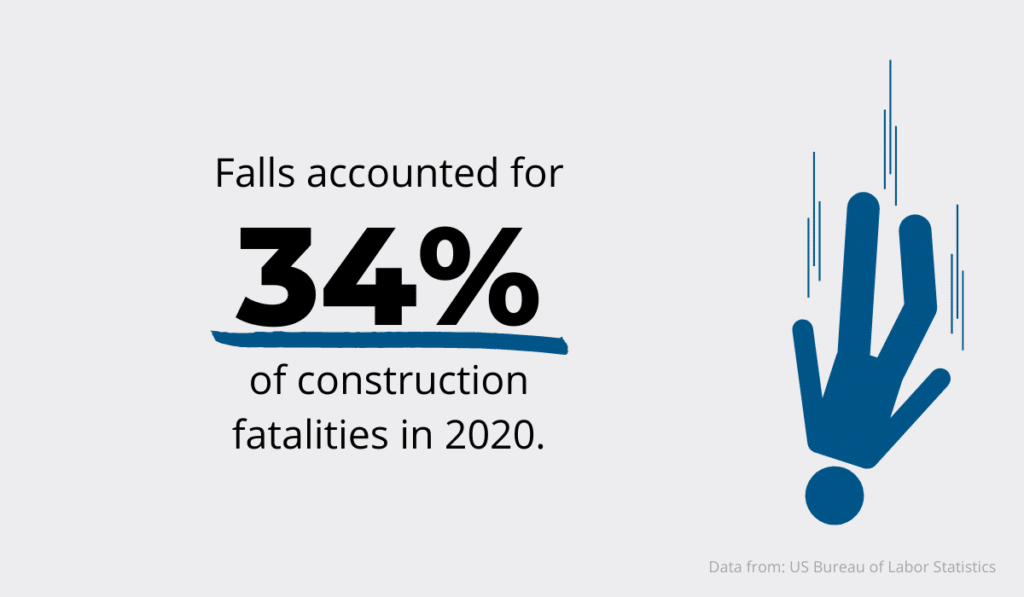
Analyzing these incidents, OSHA cited the top three reasons why fatal falls occur:
- fall protection equipment not provided, not used or inadequate
- unsafe ladder use
- lack of fall protection training
On the subject of fall protection equipment, a special mention needs to go to safety harnesses. They’re any construction worker’s best friend when it comes to fall protection.
That’s why OSHA sets a special safety standard called Duty to Have Fall Protection that covers safety harnesses and directs workers to wear a harness properly when required, inspect the harness prior to each use and calculate fall distances for the current task.
To sum up, remember that it’s the employer’s duty to provide the required PPE and relevant training at no cost to the worker. And it is the worker’s duty to use it.
If you want to do it right and read more general PPE tips, click here.
Handling Tools Inappropriately
The U.S. Bureau of Labor Statistics keeps a separate category for injuries sustained when handling equipment, titled “Struck by object or equipment”.
Although the number of fatalities in this category is about 10% lower in 2020 than it was in 2019, it’s still among the leading causes of serious accidents, according to their study that we’ve cited in earlier sections.
Suffice it to say, the correlation between heavy construction machinery and work injuries is strong, so it’s no surprise that OSHA inspectors pay special attention to equipment.
Construction sites are brimming with bulldozers, cranes, excavators, forklifts, skid-steer loaders, and similar machines.
Any of them can malfunction and lead to accidents, but even fully functional equipment can be the cause of injuries.
For example, one aspect of handling heavy machinery is loading and unloading it from flatbed trucks or other vehicles. This may seem simple, but it comes with its own inherent hazards.
As you’ll see in this video, a lot of things can go wrong.
That’s why it’s imperative that heavy equipment be managed with extra care and following all the relevant safety procedures and regulations.
Just like with heavy equipment, it’s important to take precautions when using hand and power tools.
First off, any person using hand and power tools should follow the instructions on proper use supplied by the manufacturer.
The greatest injury hazards associated with hand and power tools on construction sites stem from their misuse and poor maintenance.
Here are just a few examples of inappropriate and dangerous ways to use your power tools:
- Failing to cut away from your body when using a cutting tool
- Pushing on a wrench to loosen a tight screw
- Using a completely different tool if you don’t have the right one on hand
Avoid these to minimize the likelihood of injury.
Remember, safety instructions, regulations and procedures come with every piece of equipment for a reason. Follow them to the letter to avoid worksite injuries.
Sacrificing Training When Rushing to Meet Goals
“We’ll keep this short as we’re running out of time.”
This certainly isn’t a sentence you want to hear when attending training for construction machine operators or a course on construction job hazards.
However, the truth is construction is a highly competitive market, and when you have a tight deadline, it’s easy to be tempted to let safety slip to the wayside in an effort to secure your earnings.
But in reality, insisting on good training and worker safety can actually protect your profits and even increase them.
Here’s a couple of reasons why that is.
First of all, OSHA estimates that, if a construction company invests in an effective safety and health program, it can save $4 to $6 for every $1 invested.
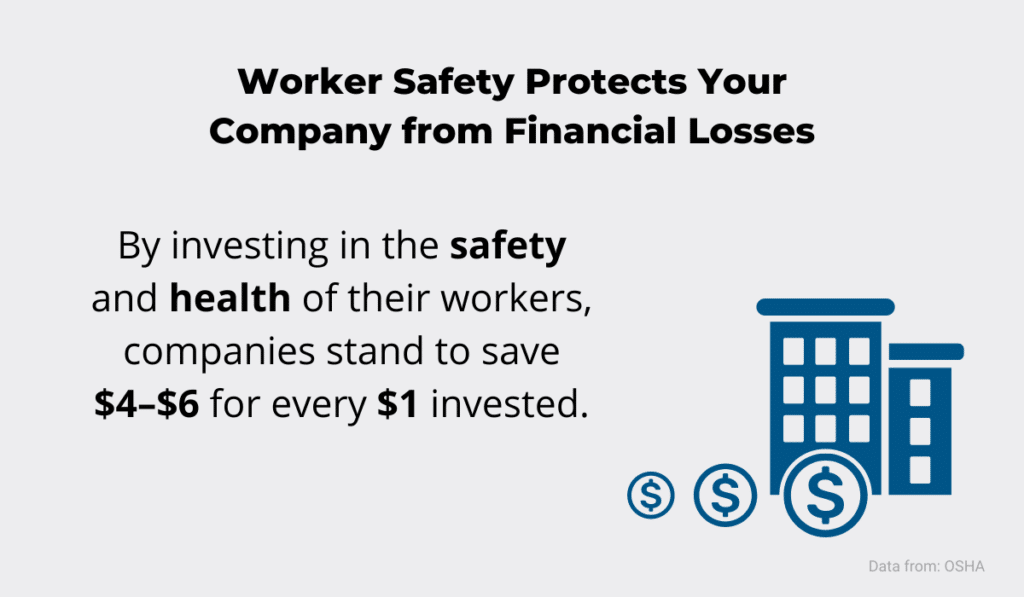
That’s because accidents are more expensive than a lot of company owners realize. Therefore, preventing them from happening can definitely be considered a sound business practice.
But that’s not all. If your workers see that you prioritize their safety over turning a quick profit, they’re more likely to see your company as a good place to work. And that, in turn, may result in higher productivity and workplace satisfaction.
Secondly, construction companies on average spend 3.6% of their budgets on workers’ compensation, but only 2.6% on safety training.
In other words, they spend more money on the consequences of poor safety practices than they do on training to prevent them from occurring in the first place.
All of this should be enough to convince you that quality training is worth the investment, so see what you can do to expand and improve your practices and make sure every worker understands how to work safely and effectively.
For example, it’s not uncommon for construction sites to employ workers whose first language isn’t English.
If your site is the same, are you taking steps to ensure these workers understand their training completely and know all of the safety procedures that govern your site?
Research shows that small construction firms are less likely to take the language and literacy issues faced by non-native workers into account.
However, OSHA specifically prescribes that workers must be trained about job hazards in a language they can understand.
Contrary to popular belief, quality training and insistence on worker safety don’t stand in the way of your business goals. In fact, they’re an aspect of your company that can help you grow.
Conclusion
The construction industry is an exciting field to work in, that much is certain.
Unfortunately, it’s also the industry where even the simplest mistakes can have devastating and far-reaching consequences.
In this article, we’ve covered some of the most common mistakes made at construction sites.
All of these mistakes can occur if you don’t pay enough attention to regulations concerning the workers’ safety, equipment handling practices, and quality training methods.
After you’re done reading this article, take some time to think about the weak links in your own site management and start finding ways to avoid these mistakes to keep your workforce protected.









